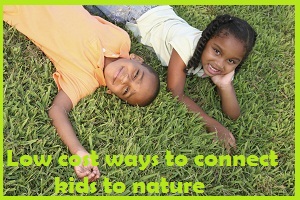Park and recreation agencies across the country recognize that children today are spending less time outdoors in nature than ever before.
At the same time agency budgets are shrinking rapidly, making the goal of engaging more children in the outdoors an even larger challenge. How do you reconcile the two? Well, park and recreation agencies certainly do not lack for creativity when it comes to finding solutions to help improve their communities especially when it comes to children and nature.

We talked with several agencies involved in connecting kids with nature and they shared with us how they implemented some simple, yet cost-effective ways to increase the number of children engaged in nature programming.
Take a look at the list and think about how you might be able to apply these best-practices in your community:
- Partner with other organizations in your community – Now more than ever it is important for park and recreation agencies to engage with other organizations in your local community. Agencies can expand and strengthen existing partnerships, utilizing partner resources like social media to increase participation. You can also develop partnerships with new, non-traditional partners in your community.
- Incorporate nature lessons and outdoor time into existing programming -- In Greensboro, South Carolina, one of the summer feeding programs for children from low-income communities incorporates an environmental theme into their activities. The children compost, spend additional time outdoors after lunch, and divide into groups based on environmental themes like “Team Recycle”.
- Be a resource for your school district – While every park and recreation department has a unique relationship with local public schools, improving this relationship can lead to greater impact for the community. Consider joint programming and create a curriculum that meets your state’s science curriculum standards.
- Meet the children where they live – In Boston, Massachusetts, park leaders implemented ParkSCIENCE events at neighborhood parks that were easily accessible to children and families. In 2012, they hosted 5 events around Boston reaching over 1,800 children who normally would not have access to environmental education programming.
- Find a ‘ring leader’ who will activate, network and convey passion for nature education projects – In every community there are people who love to champion a good program. Look for that one volunteer who is passionate about your programming and will assist with networking in the community.
- Update programming and marketing to stay current with trends – Utilize pop culture to attract children. Many agencies used themes from movie “Dr. Seuss’ The Lorax” last summer to gain interest in existing programming.
Is your agency utilizing other best practices for conservation outreach? How have you been resourceful when it comes to conservation programming? Tweet us on Twitter with your ideas (@NRPA_News #10MKids) or connect with your peers by logging in on NRPA Connect.
Shelley R. O'Brien is NRPA’s Senior Manager of Fundraising.

